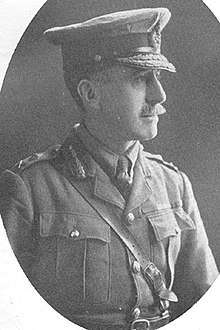Frederick Wing
Major-General Frederick Drummond Vincent Wing, CB (29 November 1860 – 2 October 1915) was a senior officer of the British Army during the First World War and was one of three British divisional commanders killed in action in the space of a week in the aftermath of the Battle of Loos. Wing had served in the army for over thirty years at the time of his death, having been commissioned into the Royal Artillery in 1880. He had served with distinction in the Second Boer War and been an aide de camp to Lord Roberts in 1903.
Frederick Wing | |
|---|---|
 | |
| Born | 29 November 1860 |
| Died | 2 October 1915 (aged 54) |
| Allegiance | |
| Service/ | |
| Years of service | 1880 to 1915 |
| Rank | Major-General |
| Commands held | 12th Infantry Division |
| Battles/wars | Second Boer War First World War |
| Awards | Companion of the Order of the Bath |
Military service
Frederick Wing was born in 1860, the son of Major Vincent Wing and Gertrude Elizabeth Wing (née Vane). In 1880 aged twenty, Wing joined the Royal Horse Artillery after graduating from the Royal Military Academy, Woolwich. Wing rose in prominence in the regiment, and was promoted to Captain on 12 September 1888, and Major on 31 March 1898.
He served in South Africa for the Second Boer War between 1899 and 1902, where he took part in operations in Natal in late 1899, including engagements at Talana. The following year, he took part in the defence of Ladysmith and was present at the Battle of Lombard´s Kop, where he was slightly wounded, and for which he was mentioned in despatches and received a brevet promotion as lieutenant-colonel on 29 November 1900. In early 1902 he was again wounded, but discharged to duty shortly before the end of hostilities, in May 1902.[1] In a despatch dated 23 June 1902, Lord Kichener wrote that Wing had "high reputation for boldness and dash" and had "rendered good service."[2] He left Cape Town on board the SS Dunvegan Castle in late June 1902,[3] and arrived at Southampton the next month. For his service in the war, he was appointed a Companion of the Order of the Bath (CB) in the October 1902 South Africa Honours list.[4]
Following his return to the United Kingdom, Wing was appointed in command of the Z Battery, Royal Horse Artillery, stationed at Newbridge.[5] He did not stay there long, however, as he was seconded to the staff of Lord Roberts, whom he served as aide-de-camp in 1903.[6]
In 1905, Wing married Mary FitzClarence, a granddaughter of the Earl of Munster and Earl of Clonmell.[7]
In 1913, Wing was given command of the artillery corps of the 3rd Infantry Division and accompanied them to France in 1914 at the outbreak of the First World War. Wing served at all the major battles of 1914 and was wounded on 22 September 1915 by a shrapnel bullet in the calf, but returned to duty the next day. Wing also had a close escape early in 1915, when a German shell burst directly over his car during a tour of his artillery positions. Wing was unhurt in the blast, but his chauffeur was wounded in the arm.[6]
Later in 1915, Wing took overall command of the newly raised New Army 12th (Eastern) Division. In the September 1915 Battle of Loos, generals George Thesiger and Thompson Capper were killed, and less than a week later, on 2 October 1915, a shell exploded in the road outside the 12th Division's forward report centre at Mazingarbe and killed Wing and his aide-de-camp Lieutenant Tower outright at 3:45pm.[6] Both were buried in the nearby Noeux-les-Mines Communal Cemetery which is now maintained by the Commonwealth War Graves Commission.[8]
Time for his men
In the diaries of Lieut A A de Jongh of the 7th Battalion, Suffolks who fought at Loos under Major General Wing, he described meeting him on 5 June 1915 while marching to Campagne. "On the way we passed Major General Wing our Divisional Commander, a simply topping man. He stopped his car and I had quite a long chat with him." On 8 July 1915 he inspected the trenches just outside Plugstreet (Ploegsteert) where Lieut. de Jongh was based. "He was please with everything and spent a long time with me."
Notes
- "The War - Officers discharged to duty". The Times (36764). London. 10 May 1902. p. 12.
- "No. 27459". The London Gazette. 29 July 1902. pp. 4835–4837.
- "The Army in South Africa - Troops returning home". The Times (36804). London. 26 June 1902. p. 10.
- "No. 27490". The London Gazette. 31 October 1902. p. 6899.
- "Naval & Military intelligence". The Times (36926). London. 15 November 1902. p. 12.
- P.107-108, Bloody Red Tabs, Davies & Maddocks
- Maj.-Gen Frederick Drummond Vincent Wing, peerage.com, Daryl Lundy, Retrieved 5 July 2008
- Wing, Frederick Drummond Vincent, Commonwealth War Graves Commission, Retrieved 5 July 2008
References
- Frank Davies & Graham Maddocks (1995). Bloody Red Tabs. Leo Cooper. ISBN 0-85052-463-6.
| Military offices | ||
|---|---|---|
| Preceded by James Spens |
Commander of the 12th (Eastern) Division 15 March 1915 – 2 October 1915 |
Succeeded by A. B. Scott |